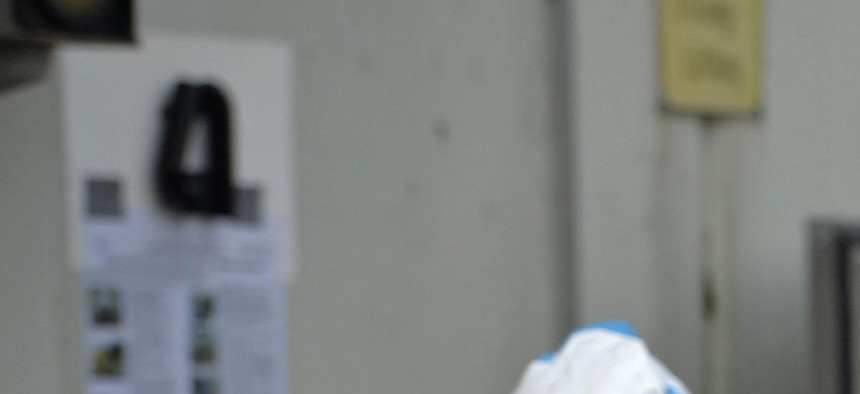
Experts at GEKA, a German state-run company, demonstrate the proper way to dispose chemical weapons. The company was tasked with dismantling Syria's chemical weapons program. Martin Meissner/AP
Is ISIS Using Chemical Weapons?
If reports that the Islamic State has used chemical weapons in Syria are true, where did they get them? By Joseph Cirincione and Paul Walker
Has the most-publicized terrorist group in the world gotten hold of chemical weapons? Maybe. If so, they may not have gotten them from where you think.
The current assault by the Islamic State of Iraq and Syria (ISIS) on the city of Kobani in northern Syria, currently in the hands of Kurds, has gone on for over three months. In early July, at least three Kurdish soldiers may have been killed by chemical weapons from ISIS. The Kurdish health minister, Nisan Ahmed, recently reported that the soldiers showed no bullet or shrapnel wounds, but clearly had burn wounds over parts of their bodies which indicated possible use of a blister agent such as phosphorous or sulphur mustard (HD).
If true, this would represent a major escalation of the violence in Syria and Iraq, and the first use of banned chemical agents since Syria joined the Chemical Weapons Convention (CWC). Chemical weapons have been used in Syria against rebel forces since at least late 2012, culminating in the August 21, 2013 attack on Ghouta outside of Damascus, but Syria joined the CWC in September 2013 as that treaty’s 190th State Party. Chlorine, a dual-use chemical not banned by the CWC but prohibited in warfare, has been used since then against rebel forces in Syria.
If these allegations about ISIS are valid, and photos of the dead Kurdish soldiers appear to confirm use of a blister agent, then where would ISIS have obtained chemical weapons?
Likely from Iraq.
An overlooked news story in June noted that ISIS forces had overtaken Fallujah, a region just west of Baghdad. Unbeknownst to many observers, Fallujah is home to a large number of former weapons bunkers of Saddam Hussein who developed a sizeable chemical weapons program in the 1980s and actively used chemical weapons in the long Iran-Iraq War that decade, indiscriminately killing thousands of Iranians.
Many of these bunkers were destroyed in the 1991 Gulf War by the United States and allies, but two large ones survived and were filled by United Nations inspectors in the mid-1990s with all of the detritus – agents, weapons, laboratory equipment, etc. – from Saddam’s chemical weapons program.
In 2009, when Iraq finally joined the Chemical Weapons Convention, it declared these two bunkers with unknown quantities of chemicals and related equipment to the Organization for the Prohibition of Chemical Weapons (OPCW) in The Hague. Fortunately, these bunkers, each the size of a football field and three stories high, had been sealed with concrete and rebar by the UN inspectors in the mid-1990s.
Iraq, with technical support from the U.S. and other countries, has been studying since 2009 how best to access these bunkers, survey and evaluate their contents, and safely destroy them, as is required under the treaty. This has unfortunately been a very slow process, partly due apparently to lack of finances and partly due to lack of knowledge about the bunkers’ contents. One major complicating factor is that one bunker holds a 2,000-pound unexploded U.S. laser-guided bomb from the 1991 war, making access a very dangerous process. Iraq began making progress this past year with construction of living quarters for some 100 workers and a laboratory for chemical analysis. It also had begun to remotely access the bunkers with robotic cameras and sniffing devices to determine what, if any, chemicals were contained therein.
This all changed with the conquest of the al-Muthanna bunkers by ISIS in June. While the U.S. and OPCW have both played down the danger of chemical weapons falling into the hands of ISIS forces, no one except the United Nations really knows what is in these two bunkers.
If ISIS gained access to the al-Muthanna bunkers in Fallujah, mustard agent could have been found and used in some capacity in the assault on Kobani.
Other possible chemical weapon sources for ISIS could be from Egypt, one of six countries that have not yet joined the CWC, and a country that used chemical weapons against Yemen over 50 years ago.
Or Syria, which has now destroyed its declared chemical weapons stockpile of some 1,300 metric tons, but just announced additional research and production facilities, previously undeclared to the OPCW.
Or Libya which destroyed some 26 metric tons of mustard agent in the last several years, but still has some 850 metric tons of precursor chemicals under reportedly very insecure circumstances.
Whether or not ISIS has actually used chemical weapons these past months, this very dangerous possibility once again points to the urgent need to take the following steps:
- Secure the al-Muthanna bunkers in Fallujah and begin a safe disposal process of all chemicals therein immediately.
- Secure the Libyan stockpile of precursor chemicals and begin safe disposal, either in Libya or outside of the country, very soon.
- Continue to press Syria for a full and verified declaration to the OPCW in order to build confidence that no chemicals have escaped the inspection process.
- Press Israel and Egypt to join the CWC as the 191st and 192nd State Parties to the abolition regime (leaving only Angola, Myanmar, North Korea, and South Sudan outside the treaty).
- Move forward with the United Nations initiated process to establish a Weapons of Mass Destruction Free Zone (WMDFZ) in the region.
Difficult steps? Absolutely. But we have no other choice. Only when all countries have banned nuclear, chemical and biological weapons, and the NPT, CWC, and BWC are universalized, will we be confident that such abhorrent, inhumane and indiscriminate weapons will not fall into the hands of such violent terrorist groups.
NEXT STORY: Obama Is Working With the Wrong Partners in Iraq




